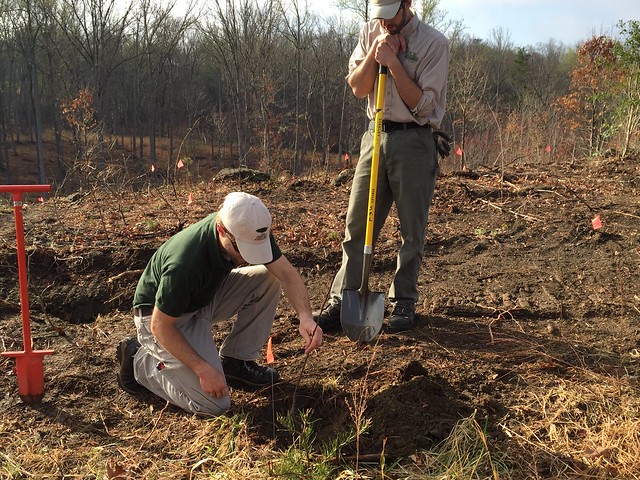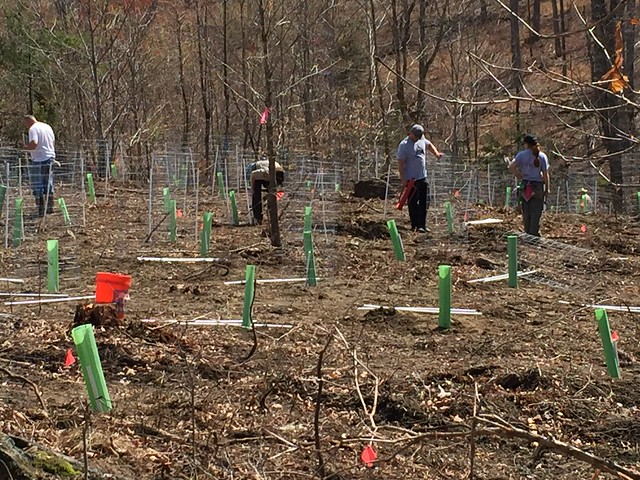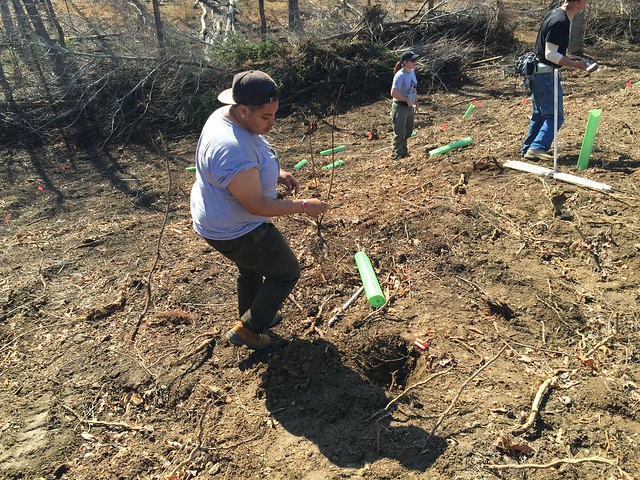Open fires are prohibited throughout the park from midnight to 4 p.m. through April 30 per the 4 p.m. Burning Law. This includes wood and charcoal. Gas is permissible. Campground fires are allowed during the restricted time if a camp host is on duty and signage to that effect is posted in the campground. Failure to observe the 4 p.m. Burning Law can result in a fine. Contact the Park Office for additional information.
Read Our Blogs
The American Chestnut Chronicle Part 3: The Restoration
Shared by Shanique Wilson, as Guest Blogger.
It has been about a hundred years since the Chestnut Blight was introduced to the United States, infecting nearly all American Chestnuts within a forty-year time span.
While I just recently found out about the devastation of the American Chestnuts, I immediately wondered how exactly this epidemic would be resolved. Surely, by now there would be research of some kind that would be trying to change the fate of the American Chestnut.

Southern Region Resource Specialist Reid Stanley works with Matt Brickman of the American Chestnut Foundation
And how right I was as the first search result brought me to the American Chestnut Foundation, an entire foundation whose sole mission is to bring back one of America’s greatest trees. They were founded and have been working on revitalizing the Chestnut population since 1983. Reading through their website and finding out exactly how they planned on bringing the population back was amazing. They were crossbreeding American Chestnuts and Chinese Chestnuts. They’ve been doing this type of breeding for some time now, hoping that their end result would be a tree with the majority (15/16) American Chestnut with the remaining sixteenth being the disease resistant gene in the Chinese Chestnut. Excited by this new development, I wanted to help out so badly! Coincidentally, the Virginia Service and Conservation Corps (VSCC) were scheduled to do a tree planting at Smith Mountain Lake State Park. What exactly were we planting? American Chestnut hybrids.
 Matt Brickman from the American Chestnut Foundation addresses volunteers
Matt Brickman from the American Chestnut Foundation addresses volunteers
We met with an American Chestnut Foundation representative, Matt Brickman, bright and early where he gave a brief but very descriptive explanation about how to plant the saplings properly and the possible environmental impact we were taking part in. With the help from all three VSCC crews, State Park staff members, the Smith Mountain Lake Friends group, and several other volunteers, we were able to plant over 450 American Chestnut saplings. It was a long hard day, but there was something inevitably heartwarming about what we were doing. Some of us knew each other but it seemed the majority were strangers, but we collectively desired to be a part of this movement, this restoration for the ages.
It’ll take some time, at least seven years before we’ll be able to find out whether the saplings survived or if they are disease resistant as we all hope them to be. For once in my life, I anticipated the coming years when I’d be able to possibly reunite with this group or my own family to see the difference we’ve made. By the time we were loading up in the van to head home, I fully believed that the American Chestnut was the tree of hope. It gave us hope for a brighter future, a future with larger forests filled once again with a tree as grand as the American Chestnut.

Volunteers work hard to help restore the American Chestnut tree
We hope that the future generations encounters involving the American Chestnut tree may sound more like this one. The swelter of the mid-afternoon sun's greetings brought hard earned sweat to the brows of many. Despite the heat, there were dozens of people, ranging from young children to the elderly, from friends to family to even strangers. They all stood in awe, some for the first time others for the last, at the sight of the Restoration Chesnuts' heights. They were towering above everything else, trunks that were strong and able, limbs that stretched upward to the sun, welcoming it with much more content than the volunteers below. There were empty Chestnuts littering the floor while its branches offered shade. The gathering was a celebration, a heart warming sight that would hopefully inspire the group that the tedious care of nature was worthwhile. Like so many other helpers, wanting to make a difference in the ever changing world, the Restoration Chestnuts stood proudly as a product of hard work, dedication, and most importantly, love.
The day's speaker told a story, reminding them that it really didn't matter that their reasons for helping and conserving the Earth differed, all that mattered was that they wanted to make a difference, that they were constantly hopeful for their world's future. They were told that the great Chestnuts before them had once, many years ago, been small saplings with people desperate for them to once again thrive in the forests, and now they were standing proud, slowly repopulating themselves. And all it took was some determination and hope.
The effort to save this piece of American history is far from over and we are proud that we have been a part of the restoration and the future for these important trees.
If you have read the article and have a question, please email nancy.heltman@dcr.virginia.gov.
Search for blogs
By Park
Categories
Cabins
Camping
Fishing
History and Culture
Other
Programs and Events
Trails
Volunteers
Water Fun
Archive
2024
2023
2022
2021
2020
2019
2018
2017
2016
2015
2014
2012















